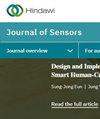具有收发器噪声的能量收集无线传感器网络中的高能效和弹性安全路由:EcoSecNet 设计与分析
IF 1.4
4区 工程技术
Q3 ENGINEERING, ELECTRICAL & ELECTRONIC
引用次数: 0
摘要
使用基于能量收集的物理层安全(PLS)的合作能量收集无线传感器网络(EH-WSN)似乎是同时满足信息安全和能源效率目标的一种有前途的方法。PLS 利用能量收集(EH)功能在传输过程中保护数据。这样就不需要传统的上层数据加密。不过,这种方法也带来了新的挑战,尤其是在潜在对手可以通过网络中继拦截敏感信息的情况下。当涉及到多跳、多径合作 EH-WSN 时,如何在降低窃听风险的同时优化 EH 的发射功率变得更加复杂。本研究提出了三种路由协议,即直接路由指定(DRD)、临时路由指定(CRD)和超级路由指定(SRD)。在存在窃听者和收发器噪音的情况下,这些协议将提高多跳、多路径合作 EH-WSN 的安全性。在这个框架中,源节点和中继节点都使用功率波束技术,使其数据传输操作更容易。本研究在协议建议之外,还提出了每种协议在各种窃听攻击情况(即窃听者协调和不协调)下的全面闭式公式和渐近中断概率分析。根据仿真数据,当窃听者不协调时,建议的 SRD 协议比 CRD 和 DRD 协议分别优胜 19% 和 25%。在窃听者协调的情况下,建议的 SRD 协议分别比 CRD 和 DRD 协议优胜 28% 和 32%。本文章由计算机程序翻译,如有差异,请以英文原文为准。
Energy-Efficient and Resilient Secure Routing in Energy Harvesting Wireless Sensor Networks with Transceiver Noises: EcoSecNet Design and Analysis
Cooperative energy harvesting wireless sensor networks (EH-WSNs) using energy-harvesting-based physical layer security (PLS) appears to be a promising way to meet information security and energy efficiency goals at the same time. PLS uses energy harvesting (EH) features to protect data while transmitting. This eliminates the need for traditional upper-layer data encryption. However, this method introduces new challenges, particularly in scenarios where potential adversaries can intercept sensitive information through network relays. When it comes to multihop, multipath cooperative EH-WSNs, it becomes even more complicated to optimize transmit power for EH while reducing eavesdropping risk. In this study, three routing protocols, direct route designation (DRD), casual route designation (CRD), and superlative route designation (SRD) are presented. The protocols will improve multihop, multipath cooperative EH-WSNs’ security in the presence of eavesdroppers as well as noises at the transceiver. In this framework, both source nodes and relay nodes use power-beaming techniques to make their data transmission operations easier. This study goes beyond the protocol recommendations by presenting comprehensive closed-form formulas and asymptotic outage probability analysis for each protocol under various eavesdropping attack scenarios, i.e., coordination and noncoordination of eavesdroppers. According to simulation data, the suggested SRD protocol outperforms the CRD and DRD protocols by 19% and 25%, respectively, when eavesdroppers are not coordinating. The suggested SRD protocol outperforms the CRD and DRD protocols by 28% and 32%, respectively, in terms of eavesdropper coordination.
求助全文
通过发布文献求助,成功后即可免费获取论文全文。
去求助
来源期刊

Journal of Sensors
ENGINEERING, ELECTRICAL & ELECTRONIC-INSTRUMENTS & INSTRUMENTATION
CiteScore
4.10
自引率
5.30%
发文量
833
审稿时长
18 weeks
期刊介绍:
Journal of Sensors publishes papers related to all aspects of sensors, from their theory and design, to the applications of complete sensing devices. All classes of sensor are covered, including acoustic, biological, chemical, electronic, electromagnetic (including optical), mechanical, proximity, and thermal. Submissions relating to wearable, implantable, and remote sensing devices are encouraged.
Envisaged applications include, but are not limited to:
-Medical, healthcare, and lifestyle monitoring
-Environmental and atmospheric monitoring
-Sensing for engineering, manufacturing and processing industries
-Transportation, navigation, and geolocation
-Vision, perception, and sensing for robots and UAVs
The journal welcomes articles that, as well as the sensor technology itself, consider the practical aspects of modern sensor implementation, such as networking, communications, signal processing, and data management.
As well as original research, the Journal of Sensors also publishes focused review articles that examine the state of the art, identify emerging trends, and suggest future directions for developing fields.
 求助内容:
求助内容: 应助结果提醒方式:
应助结果提醒方式:


